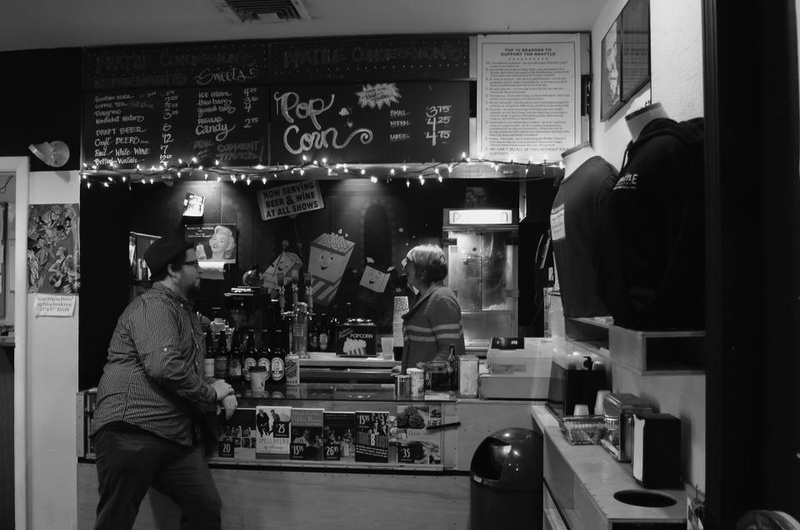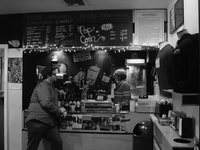
Ned Hinkle, creative director of the Brattle Theater, checks in on one of his managers, Kelly McMaster.
“Sure I’ve heard of the Brattle Theatre!” Steve A. Buschbach ’16 says. “Where is it again?”
His response was a typical one. Most Harvard students, it seems, are aware of the Brattle Theatre, having passed it en route to Café Algiers or American Apparel or contemplated taking a date there. But of the nearly dozen students I approached, only one had actually patronized the tiny cinema. Preoccupied with extracurriculars, relationships, and spring classes that are quickly exiting the honeymoon phase, the average Harvard student, it seems, has little time to ponder the state of his neighborhood movie theater.
The Brattle is not the only one of its kind. While the number of independent movie theaters in the United States has declined over the years, the Boston area boasts an unusually high concentration of non-chain cinemas. Four such independent cinemas are located within five miles of Cambridge: the Coolidge Corner Theatre, located in Brookline; the Somerville Theatre; the Harvard Film Archive; and, of course, the Brattle. Each of these institutions has a rich and decades-long history, and the success these theaters are enjoying in spite of an onslaught of 21st-century technology suggests that the history behind them will continue to accrue.
REELS STILL SPINNING
It might be expected that the ledgers of local, independent theaters would offer bleak accounts of declining viewership and sinking incomes. But the Cambridge-area independents offer a glorious affront to current trends. Each is comfortably in the black.
Ned R. Hinkle has been creative director for the Brattle for twelve years and has been working for the theatre since 1996. His connection to the theater goes back to his high school days, when he was a frequent visitor to the movie house. His account of the Brattle’s financial history since it became a not-for-profit theatre is encouraging. “[The Brattle Film Foundation] took over in March of 2001, then September 11 happened. Corporate money dried up overnight; audiences retreated. But we’ve been able to grow the audience over the years,” he says. “We’ve had three straight years of audience growth.” This is especially impressive given recent patterns for the film industry in general. “While the movies make tons of money, it’s because they keep raising ticket prices. Really, what’s happening is the number of people who go to see movies in movie theaters is declining,” Hinkle says.
The Harvard Film Archive has also enjoyed viewership stability. According to Brittany B. Gravely, who studied film at the School of the Museum of Fine Arts in Boston and has served as publicist for the archive for a little over two years, the archive won’t be in financial trouble anytime soon. “It seems like we have a fairly steady flow of patrons,” she says. “We still have sold-out shows pretty frequently.”
The theaters in Harvard Square are not the only ones that have remained solvent over the years. According to employees at both the Coolidge Corner Theatre in Brookline and the Somerville Theatre, audience sizes have remained healthy. “As a whole [viewership] has increased tremendously,” Ian M. Judge, director of operations at the Somerville, says. “We [recently] pushed through to become a first-run movie theatre…. Since then, our attendance has grown.”
Read more in Arts
BPO Returns to Fateful SymphonyRecommended Articles
-
Harvey May Sell Harvard Square TheaterCyrus I. Harvey '47, the founder of Janus Films who helped make movies respectable in Cambridge, is negotiating the sale
-
Harvard Falls Once Again to the TigersThis past weekend at the annual HYP meet, hosted this year by Yale, the Crimson handily topped the Bulldogs, 217-83, but lost to the Tigers, 207-93.
-
 Jonah Hill Sits Down with Crimson Arts
Jonah Hill Sits Down with Crimson Arts -
Tradition, Technology, and Blockbuster BalletRadio stations are playing a rotation of Christmas songs, red and green decorations have replaced the Halloween candy in the seasonal isle, and the New York City Ballet has started promoting its famous version of “The Nutcracker.”
-
Students, Residents Sad to Say Goodbye to Harvard's AMC CinemaThe news that Harvard Square’s only mainstream movie theater will close in early July was met with sadness by Cambridge residents and Harvard students this week.
-
 Outings and Innings Offers Cheaper Movie Tickets
Outings and Innings Offers Cheaper Movie Tickets














